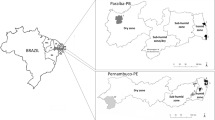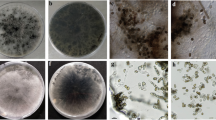Abstract
The production of avocado in Peru has been increasing over the last five years and it represents a major export commodity. However, dieback symptoms, typical of Botryosphaeriaceae, have been observed in avocado orchards throughout the country, leading to economic losses. Thus, this study aimed to evaluate the diversity and pathogenicity of species associated with dieback of avocado trees, in the Peru’s Pacific coastline. On the basis of morphological and cultural characters, as well as phylogenetic analysis of the internal transcribed spacer region (ITS) and part of the translation elongation factor 1-α gene (tef1-α), the isolates were identified as belonging to three Lasiodiplodia species, namely L. theobromae, L. laeliocattleyae and L. pseudotheobromae. Inoculation in cv. ‘Hass’ plants confirmed the pathogenicity of Lasiodiplodia species and revealed differences in aggressiveness among species and isolates. Lasiodiplodia laeliocattleyae is reported for the first time in avocado trees associated with dieback symptoms, which together with L. theobromae and L. pseudotheobromae may represent a threat to Peruvian avocado plantations.





Similar content being viewed by others
References
Alama, I., Maldonado, E., & Rodríguez-Gálvez, E. (2006). Lasiodiplodia theobromae affect the cultivation of Palto (Persea americana) under the conditions of Piura, Peru. Universalia, 11, 4–13.
Alves, A., Correia, A., Luque, J., & Phillips, A. J. L. (2004). Botryosphaeria corticola, sp. nov. on Quercus species, with notes and description of Botryosphaeria stevensii and its anamorph, Diplodia mutila. Mycologia, 96, 598–613.
Alves, A., Phillips, A. J. L., Henriques, I., & Correia, A. (2007). Rapid differentiation of species of Botryosphaeriaceae by PCR fingerprinting. Research in Microbiology, 158, 112–121.
Alves, A., Crous, P. W., Correia, A., & Phillips, A. J. L. (2008). Morphological and molecular data reveal cryptic speciation in Lasiodiplodia theobromae. Fungal Diversity, 28, 1–13.
Arjona-Girona, I., Ruano Rosa, D., & López Herrera, C. (2019). Identification, pathogenicity and distribution of the causal agents of dieback in avocado orchards in Spain. Spanish Journal of Agricultural Research, 17, e1003.
Auger, J., Palma, F., Pérez, I., & Esterio, M. (2013). First report of Neofusicoccum australe (Botryosphaeria australis), as a branch dieback pathogen of avocado trees in Chile. Plant Disease, 97, 842–842.
Batista, E., Lopes, A., & Alves, A. (2021). What do we know about Botryosphaeriaceae? An overview of a worldwide cured dataset. Forests, 12, 313.
Chen, S., Morgan, D. P., Hasey, J. K., Anderson, K., & Michailides, T. J. (2014). Phylogeny, morphology, distribution, and pathogenicity of Botryosphaeriaceae and Diaporthaceae from English walnut in California. Plant Disease, 98, 636–652.
Chen, J., Zhu, Z., Fu, Y., Cheng, J., Xie, J., & Lin, Y. (2021). Identification of Lasiodiplodia pseudotheobromae causing fruit rot of Citrus in China. Plants, 10, 202.
Correia, K. C., Câmara, M. P. S., Barbosa, M. A. G., Sales Jr., R., Agustí-Brisach, C., Gramaje, D., León, M., García-Jiménez, J., Abad-Campos, P., Armengol, J., & Michereff, S. J. (2013). Fungal trunk pathogens associated with table grape decline in northeastern Brazil. Phytopathologia Mediterranea, 52, 380–387.
Cruywagen, E. M., Slippers, B., Roux, J., & Wingfield, M. J. (2017). Phylogenetic species recognition and hybridisation in Lasiodiplodia: A case study on species from baobabs. Fungal Biology, 121, 420–436.
FAOSTAT. (2021). Food and Agriculture Organization of the United Nations. http://www.fao.org/faostat/en/#home. Accessed 01 March 2021.
Galindo-Tovar, M. E., Arzate-Fernández, A. M., Ogata-Aguilar, N., & Landero-Torres, I. (2007). The avocado (Persea Americana, Lauraceae) crop in Mesoamerica: 10,000 years of history. Harvard Papers in Botany, 12, 325–334.
Garcia, F., & Davidov-Pardo, G. (2021). Recent advances in the use of edible coatings for preservation of avocados: A review. Journal of Food Science, 86, 6–15.
Garibaldi, A., Bertetti, D., Amatulli, M. T., Cardinale, J., & Gullino, M. L. (2012). First report of postharvest fruit rot in avocado (Persea americana) caused by Lasiodiplodia theobromae in Italy. Plant Disease, 96, 460.
Guarnaccia, V., Vitale, A., Cirvilleri, G., Aiello, D., Susca, A., Epifani, F., Perrone, G., & Polizzi, G. (2016). Characterisation and pathogenicity of fungal species associated with branch cankers and stem-end rot of avocado in Italy. European Journal of Plant Pathology, 146, 963–976.
Hall, T. A. (1999). BioEdit: A user-friendly biological sequence alignment editor and analysis program for windows 95/98/NT. Nucleic Acids Symposium Series, 41, 95–98.
Hilário, S., Amaral, I., Gonçalves, F. M., Lopes, A., Santos, L., & Alves, A. (2020). Diversity and pathogenicity of Diaporthe species on blueberry plants in Portugal, with description of four new species. Mycologia, 112, 293–308.
Icochea, T., Perez, W., & Torres, H. (1995). First report of black rot of Oxalis tuberosa tubers caused by Lasiodiplodia theobromae. Plant Disease, 79, 425.
Ismail, A. M., Cirvilleri, G., Polizzi, G., Crous, P. W., Groenewald, J. Z., & Lombard, L. (2012). Lasiodiplodia species associated with dieback disease of mango (Mangifera indica) in Egypt. Australasian Plant Pathology, 41, 649e660.
Javier-Alva, J., Gramaje, D., Alvarez, L. A., & Armengol, J. (2009). First report of Neofusicoccum parvum associated with dieback of mango trees in Peru. Plant Disease, 93, 426–426.
Kumar, S., Stecher, G., & Tamura, K. (2016). MEGA7: Molecular evolutionary genetics analysis version 7.0 for bigger datasets. Molecular Biology and Evolution, 33, 1870–1874.
Larkin, M. A., Blackshields, G., Brown, N. P., Chenna, R., McGettigan, P. A., McWilliam, H., Valentin, F., Wallace, I. M., Wilm, A., Lopez, R., Thompson, J. D., Gibson, T. J., & Higgins, D. G. (2007). Clustal W and Clustal X version 2.0. Bioinformatics, 23, 2947–2948.
Marques, M. W., Lima, N. B., de Morais, M. A., Barbosa, M. A. G., Souza, B. O., Michereff, S. J., Phillips, A. J. L., & Câmara, M. P. (2013). Species of Lasiodiplodia associated with mango in Brazil. Fungal Diversity, 61, 181–193.
McDonald, V., & Eskalen, A. (2011). Botryosphaeriaceae species associated with avocado branch cankers in California. Plant Disease, 95, 1465–1473.
Menge, J., & Ploetz, R. C. (2003). Diseases of avocado. In R. C. Ploetz (Ed.), Diseases of tropical fruit crops (pp. 35–71). CABI Publishing.
Ministerio de Agricultura y Riego. (2021). Gobierno del Perú: Plataforma digital única del Estado Peruano. https://www.gob.pe/minagri. Accessed February 2021.
Möller, E. M., Bahnweg, G., Sandermann, H., & Geiger, H. H. (1992). A simple and efficient protocol for isolation of high molecular weight DNA from filamentous fungi, fruit bodies, and infected plant tissues. Nucleic Acids Research, 20, 6115–6116.
Onaebi, C., Onyeke, C., Osibe, D., Ugwuja, F., Okoro, A., & Onyegirim, P. (2019). Antimicrobial activity of Ocimum gratissimum L. and Carica papaya L. against postharvest pathogens of avocado pear (Persea americana mill.). Journal of Plant Pathology, 102, 319–325.
Page, R. D. M. (1996). TreeView: An application to display phylogenetic trees on personal computers. Computer Applications in Biosciences, 12, 357–358.
Phillips, A. J. L., Alves, A., Abdollahzadeh, J., Slippers, B., Wingfield, M. J., Groenewald, J. Z., & Crous, P. W. (2013). The Botryosphaeriaceae: Genera and species known from culture. Studies in Mycology, 76, 51–167.
Pineda-Lozano, J. E., Martínez-Moreno, A. G., & Virgen-Carrillo, C. A. (2021). The effects of avocado waste and its functional compounds in animal models on dyslipidemia parameters. Frontiers in Nutrition, 8, 16.
Qiu, F., Tan, X. H., Xie, C. P., Xu, G., Li, X., Zheng, F. Q., & Wang, W. L. (2020). First report of Lasiodiplodia theobromae causing branch blight on avocado in China. Plant Disease, 104, 2728–2728.
R Core Team. (2020). R: A language and environment for statistical computing. R Foundation for Statistical Computing. http://www.R-project.org/.
Ramírez-Gil, J. G., & Peterson, A. T. (2019). Current and potential distributions of the most important diseases affecting 'Hass' avocado in Antioquia Colombia. Journal of Plant Protection Research, 59, 214–228.
Rodríguez, F., Oliver, J. L., Marín, A., & Medina, J. R. (1990). The general stochastic model of nucleotide substitutions. Journal of Theoretical Biology, 142, 485–501.
Rodríguez-Gálvez, E., Maldonado, E., & Alves, A. (2015). Identification and pathogenicity of Lasiodiplodia theobromae causing dieback of table grapes in Peru. European Journal of Plant Pathology, 141, 477–489.
Rodríguez-Gálvez, E., Guerrero, P., Barradas, C., Crous, P. W., & Alves, A. (2017). Phylogeny and pathogenicity of Lasiodiplodia species associated with dieback of mango in Peru. Fungal Biology, 121, 452–465.
Rodríguez-Gálvez, E., Hilário, S., Lopes, A., & Alves, A. (2020). Diversity and pathogenicity of Lasiodiplodia and Neopestalotiopsis species associated with stem blight and dieback of blueberry plants in Peru. European Journal of Plant Pathology, 157, 89–102.
Ronquist, F., & Huelsenbeck, J. P. (2003). MrBayes 3: Bayesian phylogenetic inference under mixed models. Bioinformatics, 19, 1572–1574.
Rosado, A. W. C., Machado, A. R., Freire, F. O., & Pereira, O. L. (2016). Phylogeny, identification and pathogenicity of Lasiodiplodia associated with postharvest stem-end rot of coconut in Brazil. Plant Disease, 100, 561e568.
Sakalidis, M. L., Ray, J. D., Lanoiselet, V., Hardy, G. E. S. J., & Burgess, T. I. (2011). Pathogenic Botryosphaeriaceae associated with Mangifera indica in the Kimberley region of Western Australia. European Journal of Plant Pathology, 130, 379–391.
Salvatore, M. M., Andolfi, A., & Nicoletti, R. (2020). The thin line between pathogenicity and endophytism: The case of Lasiodiplodia theobromae. Agriculture, 10, 488.
Slippers, B., & Wingfield, M. J. (2007). Botryosphaeriaceae as endophytes and latent pathogens of woody plants: Diversity, ecology and impact. Fungal Biology Reviews, 21, 90–106.
Swofford, D. L. (2002). PAUP*. Phylogenetic analysis using parsimony (*and other methods). Version 4.0. Sinauer associates: Sunderland, Massachusetts.
Úrbez-Torres, J. R., & Gubler, W. D. (2009). Pathogenicity of Botryosphaeriaceae species isolated from grapevine cankers in California. Plant Disease, 93, 584–592.
Valencia, A. L., Gil, P. M., Latorre, B. A., & Rosales, I. M. (2019). Characterization and pathogenicity of Botryosphaeriaceae species obtained from avocado trees with branch canker and dieback and from avocado fruit with stem end rot in Chile. Plant Disease, 103, 996–1005.
Vaydia, G., Lohman, D. J., & Meier, R. (2011). SequenceMatrix: Concatenation software for the fast assembly of multi-gene datasets with character set and codon information. Cladistics, 27, 171–180.
Wanjiku, E. K., Waceke, J. W., Wanjala, B. W., & Mbaka, J. N. (2020). Identification and pathogenicity of fungal pathogens associated with stem end rots of avocado fruits in Kenya. International Journal of Microbiology, Article ID 4063697.
White, T. J., Bruns, T. D., Lee, S., & Taylor, J. (1990). Amplification and direct sequencing of fungal ribosomal RNA genes for phylogenetics. In M. A. Innis, D. H. Gelfand, J. J. Sninsky, & T. J. White (Eds.), PCR protocols: A guide to methods and applications (pp. 315–322). Academic Press.
Wickham, H. (2016). ggplot2: Elegant graphics for data analysis. Springer-Verlag.
Zea-Bonilla, T., González-Sánchez, M. A., Martín-Sánchez, P. M., & Pérez-Jiménez, R. M. (2007). Avocado dieback caused by Neofusicoccum parvum in the Andalucia region, Spain. Plant Disease, 91, 1052–1052.
Acknowledgments
Thanks are due to the Portuguese Foundation for Science and Technology (FCT/MCTES) for the financial support to CESAM (UIDP/50017/2020 + UIDB/50017/2020), and the PhD grants of Eduardo Batista (PD/BD/135535/2018) and Sandra Hilário (SFRH/BD/137394/2018). This work was also partially financed by Universidad Nacional de Piura, Peru through the Fondo de Desarrollo Universitario (FEDU).
Author information
Authors and Affiliations
Corresponding author
Ethics declarations
All principles of ethical and professional conduct have been followed during this research and elaboration of this manuscript.
Conflict of interest
The authors declare that they have no conflict of interest.
Research involving human participants and/or animals
Not applicable.
Informed consent
All authors have reviewed the manuscript and approved its submission to the European Journal of Plant Pathology.
Rights and permissions
About this article
Cite this article
Rodríguez-Gálvez, E., Hilário, S., Batista, E. et al. Lasiodiplodia species associated with dieback of avocado in the coastal area of Peru. Eur J Plant Pathol 161, 219–232 (2021). https://doi.org/10.1007/s10658-021-02317-5
Accepted:
Published:
Issue Date:
DOI: https://doi.org/10.1007/s10658-021-02317-5




